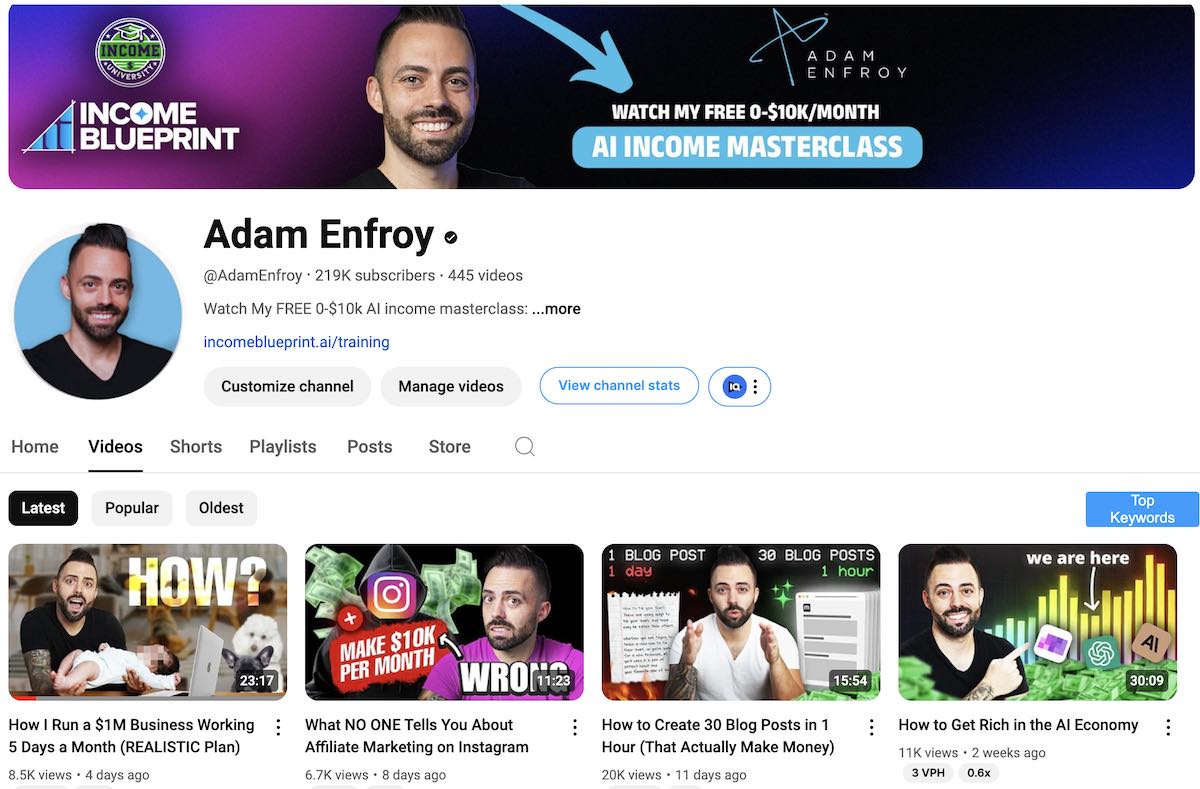How to Humanize AI Content (Beat Detection & Boost Rankings)

Everyone loves quick and easy. AI content creation tools help us achieve this.
There’s only one (big) problem… AI-generated content lacks a personal touch, leading to robotic and unengaging content that no one wants to read.
Making robot-written content “more human” is crucial.
The great news is that you can do this in a few simple steps.
In this post, I’ll share these 3 key steps. Having this knowledge will help you:
- beat detection
- boost rankings and
- make your audience fall in love with your content.
Let’s dive right in.
3 Steps To Humanize AI Content
I’ve divided the process of humanizing AI content into 3 steps:
- Preparation
- Generating Humanized Content
- Polishing The Article
All the steps are important. You should also do them in the order mentioned below.
Step 1: Preparation
Before you start creating your article, here are the steps to follow.
Use AI As A Research Assistant
AI tools are not just for writing. If you rely on them solely for that, you are missing out.
With ChatGPT’s (and other tools like Perplexity) ability to browse the internet, doing the right research will help you create a better (and more polished) article.
What does the right research involve? It’s all about finding case studies, testimonials, analogies, and stories that can humanize your content.
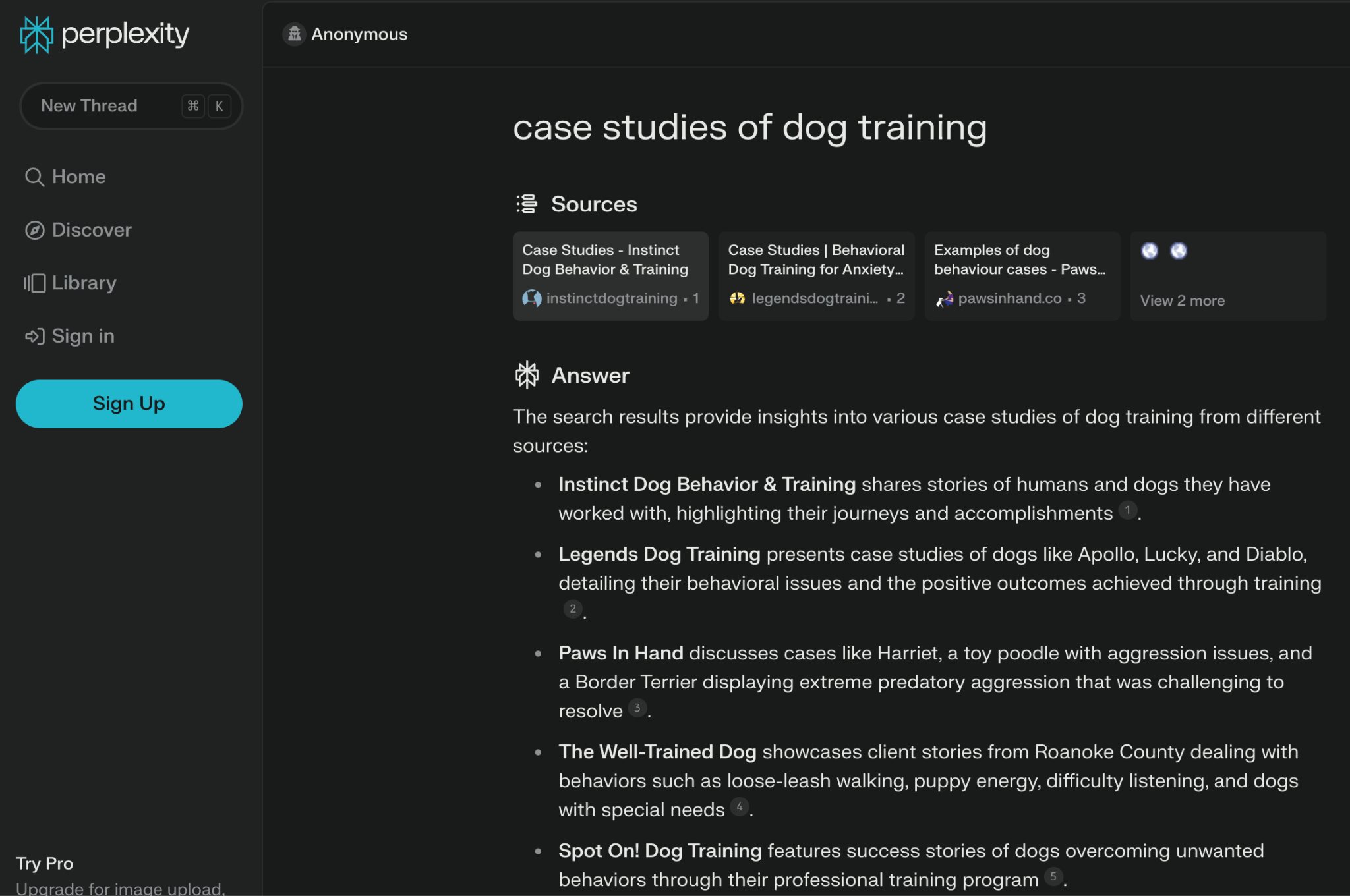
Source: https://www.perplexity.ai/
While you can do this in the article writing stage (stage 2), getting all the pieces together before writing makes the job easier.
At the point of writing, it’s all about assembling the pieces instead of creating them from scratch.
Browse The Internet For Statistics, Stories, Or Case Studies
Consider that by using the right statistics, stories, or case studies, you are demonstrating authority.
When creating content, authority is no longer a commodity. When you view someone as an authority on a topic, you are more likely to trust their words. You’ll also take what they say at face value without questioning it.
And that’s precisely how you want your audience to perceive your content.
Moreover, research will help you create content that resonates with your audience.
For content in the weight-loss niche, a before-and-after case study of someone who lost a lot of fat might be effective.
Compare this to just writing about the benefits of a particular diet or exercise regimen.
The former is an example of much more compelling content. Showing actual results and proof can make your content more compelling.
In the case of dog training, a testimonial from a happy customer (whose dog’s behavior was transformed) could be powerful.
It’s more powerful than stating the techniques used in dog training or listing the benefits of having a well-behaved dog.
If you have examples of statistics, stories, or case studies on file, you can use these for your content. You could also use AI to give you examples you can later use.
Consider Personal Stories
Adding personal anecdotes is at the heart of humanizing AI content. Preparing this in step 1 of your article creation process will pay off shortly.
Note that these anecdotes are another case of things ‘only you’ can do. No AI can dive deep into your memories and your personal experiences.
No AI can share your authentic voice without knowing what stories you’ll tell.
And this authenticity is what truly makes a connection with your audience.
Have Examples Of Your Previous Work Handy
Before I use AI to generate content, it’s helpful to have examples of work I’ve created.
Feeding this work into AI (which I’ll do in the next step) will help it model the writing based on how I write.
Whether it’s my voice, tone, or style, these examples will make the AI-generated content feel more authentic and personal.
The more examples you can have handy, the better. If you started a blog and have multiple examples to use, that is the best-case scenario.
Step 2: Generating Humanized Content
At this stage, I’m assuming you’ve done the research and got all the information I mentioned ready.
You know what stories, facts, stats, and case studies you want to include in your article.
You also have examples of past work you will share with your chosen AI content creation tool. This work will really help the tool humanize its content output.
Let’s now jump into ChatGPT and use this to create (and humanize) AI text. For this example, I will focus on an article titled “how to start a blog”.
Before I start generating text, I want to give ChatGPT examples of my past work. Here’s the first prompt I’ll use:

I then paste in my article URL. In this case, I’m using this one:
How to Sell Courses on Instagram (From a 7-Figure Creator)
ChatGPT returns this (note I’m only including part of the screenshot – the output was too long to put into a screenshot.):
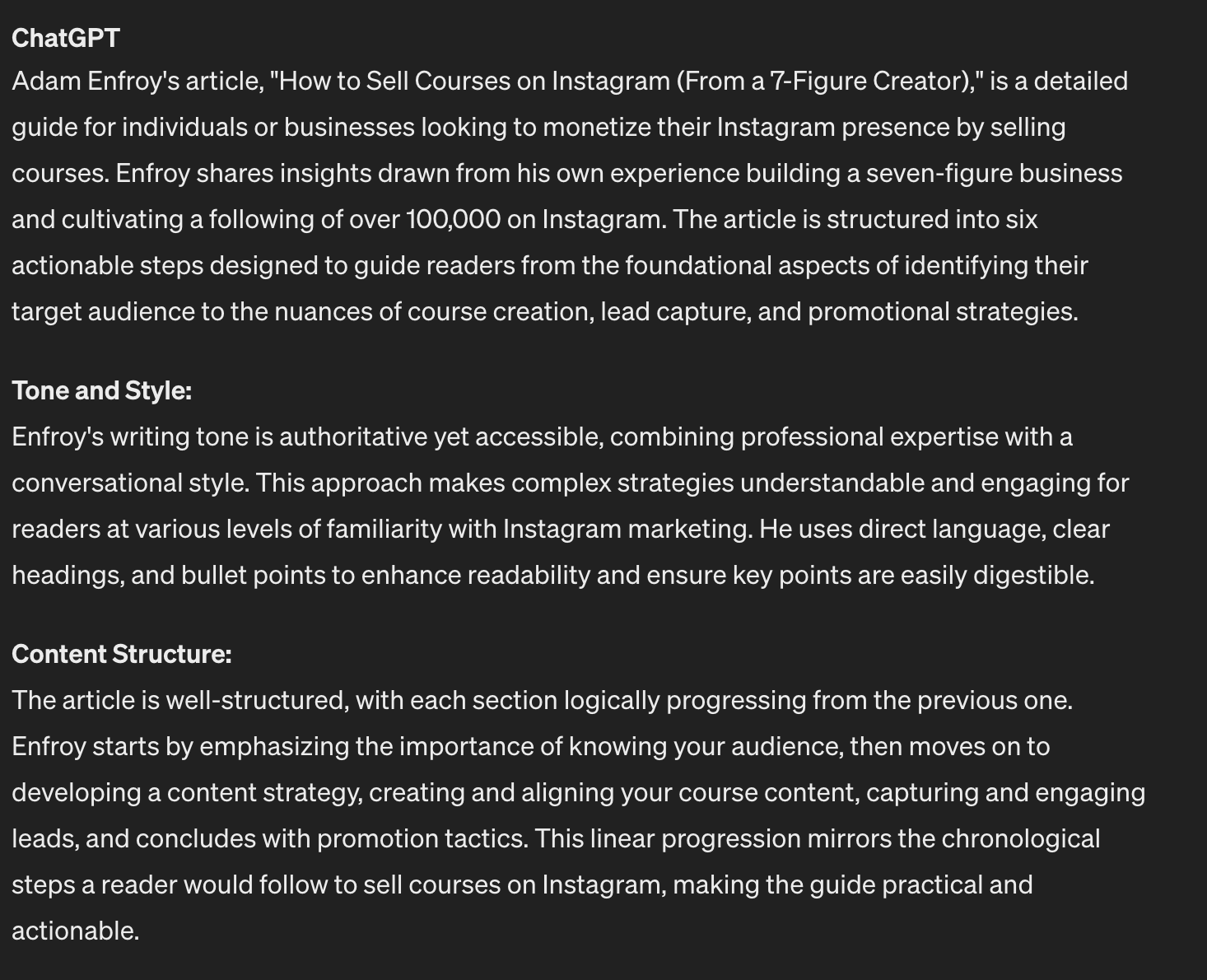
Note the ‘tone and style’ and ‘content structure’. These will be crucial to generate humanized content.
I then reply with this:

ChatGPT comes back with this:
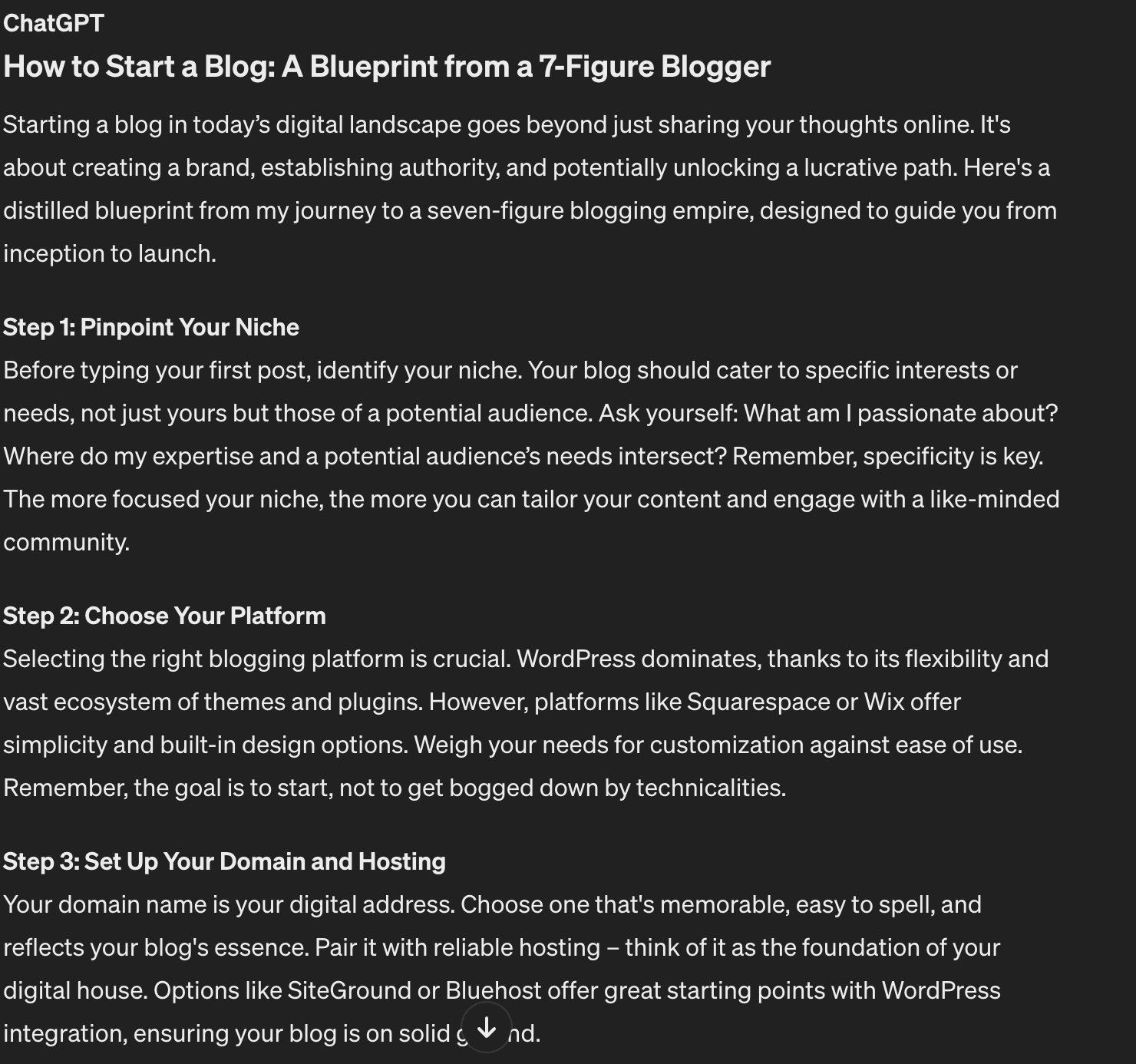
Not too bad. But, there’s one problem.
There’s no information about Adam Enfroy (i.e., me) in that article. While the contents reflect the steps to starting a blog, there’s nothing ‘personal’ about it.
Let’s fix that by using the about me page on my site. I tell ChatGPT:
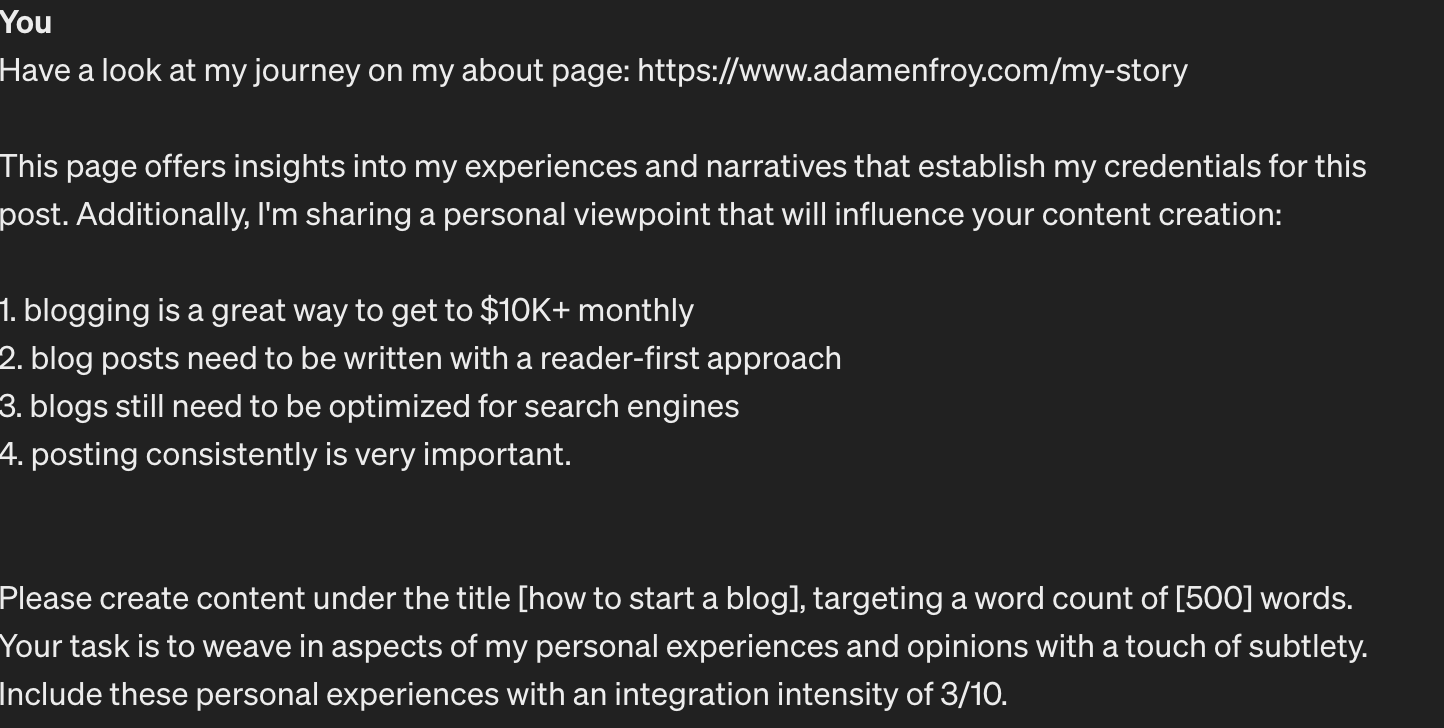
ChatGPT answers:

Great, we’re making progress.
I now want to make the sentences shorter. I’m not a big fan of those long, chunky paragraphs.
My prompt:

ChatGPT’s answer:
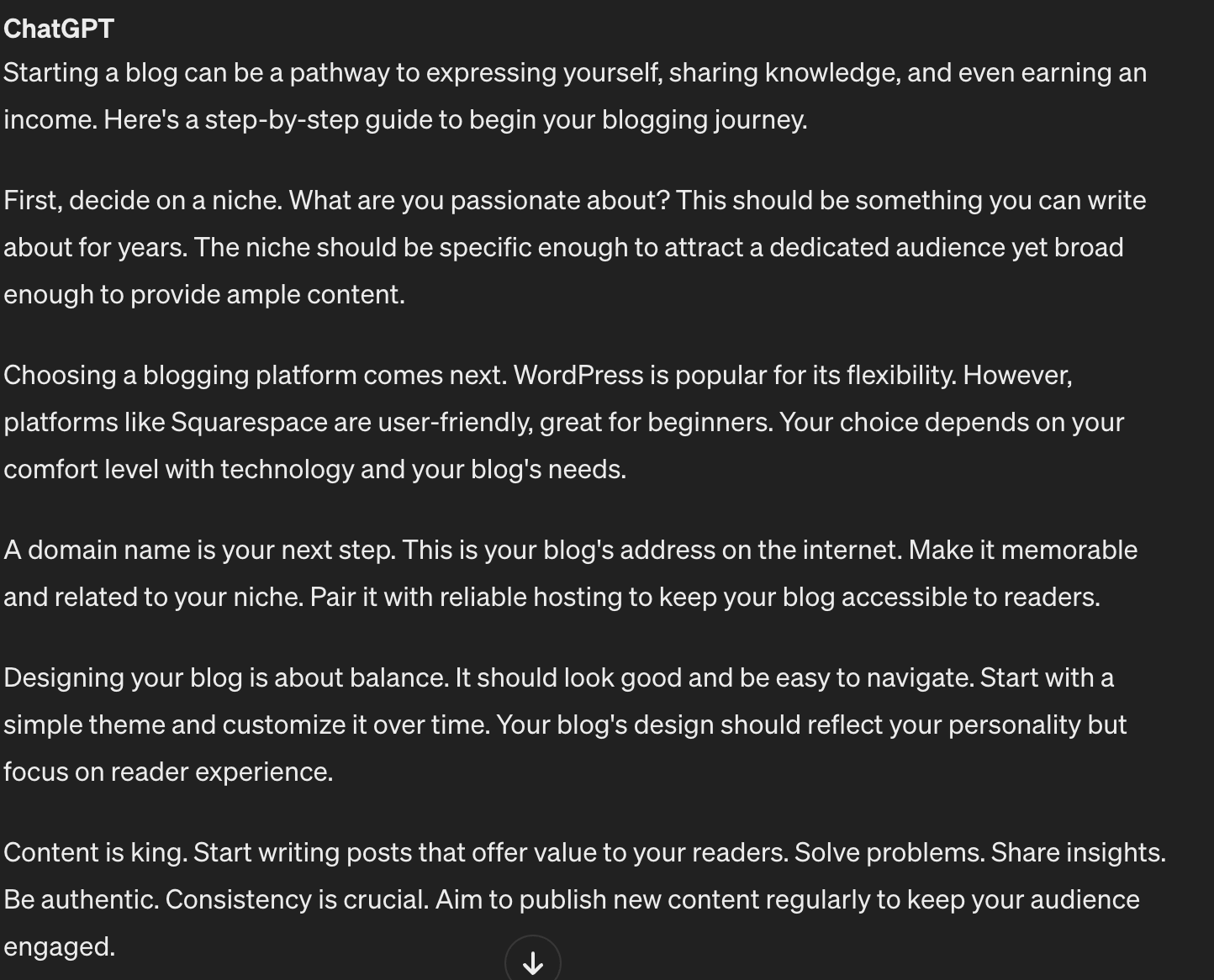
Next, using your AI content creation tool, you can humanize your article based on the following:
- Add personal anecdotes: For each step above, I can go in and ask the tool to include a story (along with possible takeaways) from each point. I can give it the rough outline and ask it to integrate this with the point.
- Add your case studies and testimonials: I can provide client success stories. The AI can then include these in the right sections.
- Add your audience personas and adapt the article towards them: Creating content for a 25-year-old man is different than creating it for a 60+ woman. If you present this information, your AI tool will be able to create better content.
- Insert more facts into the article (with external links): It’s a great idea to include external information (found in step 1) to make your article more credible.
- Beef up each paragraph to include more information: At the moment, each paragraph is a bit dry. I can ask ChatGPT to expand on each step and provide more detail.
With every iteration, you’ll get closer to an article that’s more in line with how you would create content.
Step 3: Polishing The Article
You’ve now generated your article and humanized it.
You’ve added your own expertise, stories, and external resources to make it stand out.
But what happens next?
I turn to SurferSEO and Grammarly (in that order).
Here’s why.
I first generate an article with the human reader in mind. I don’t even consider SEO when I’m building the article.
Providing valuable content means understanding what the reader is searching for and their questions.
Then, it’s about ensuring I deliver content that answers their question and provides the information they need.
When I am happy I’ve done that, I move on to the search engine optimization process.
SurferSEO helps me optimize my articles for search engines.
In SurferSEO, this is the editor window:
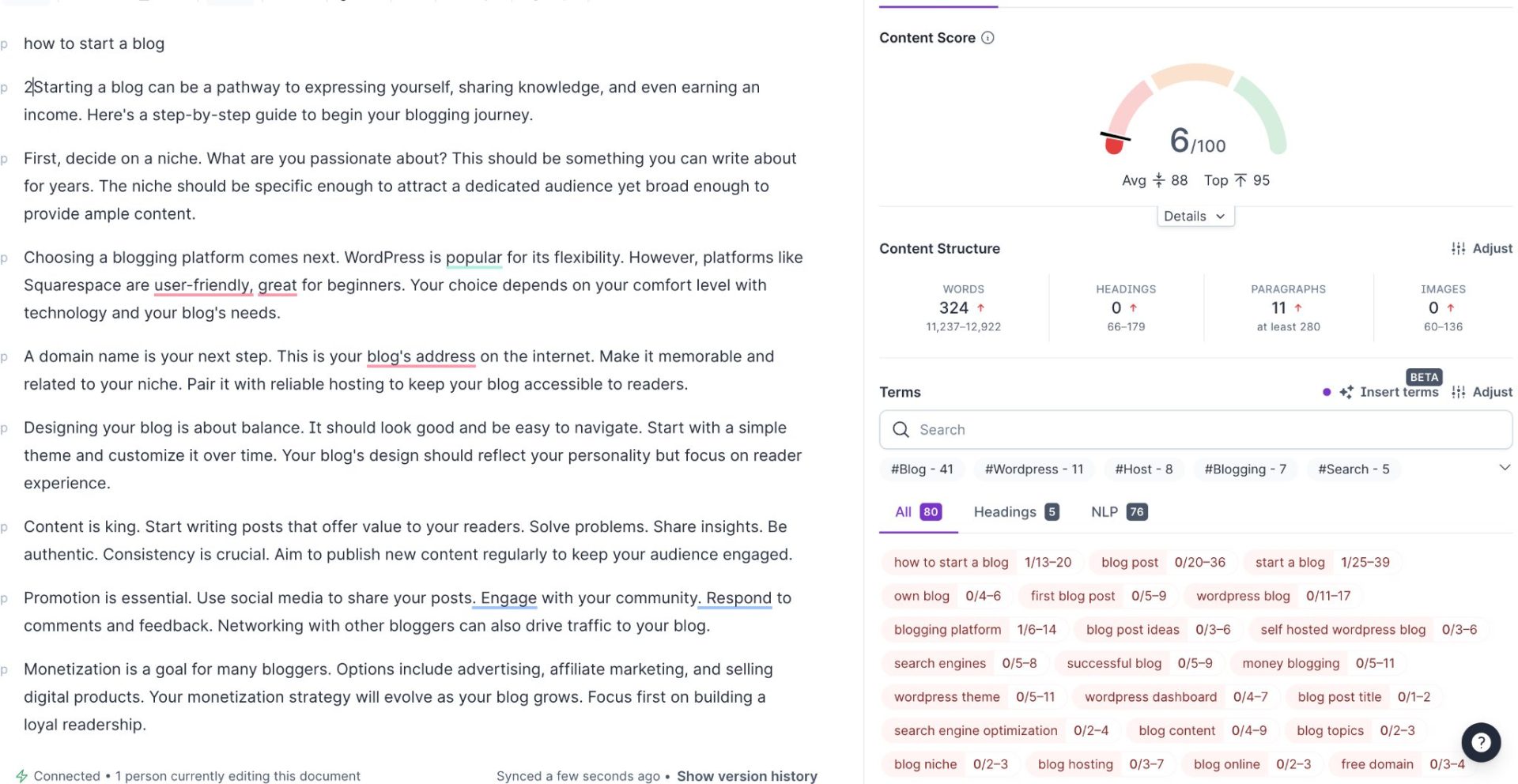
Source: https://app.surferseo.com/
I paste my article and get a score. I also get the keywords to insert into the article to increase this score.
This part is quite manual. I go through the article and add the necessary keywords where they make the most sense. I also beef up the article to improve the human experience of someone reading it.
As I read the article, I also fact-check any claims the AI-written content makes. This is 100% on me to ensure the accuracy of the information presented.
Once I’m done with SurferSEO, I move on to Grammarly.
This tool helps polish my writing and catch any grammar or spelling mistakes. It provides recommendations for better sentence structure and vocabulary.
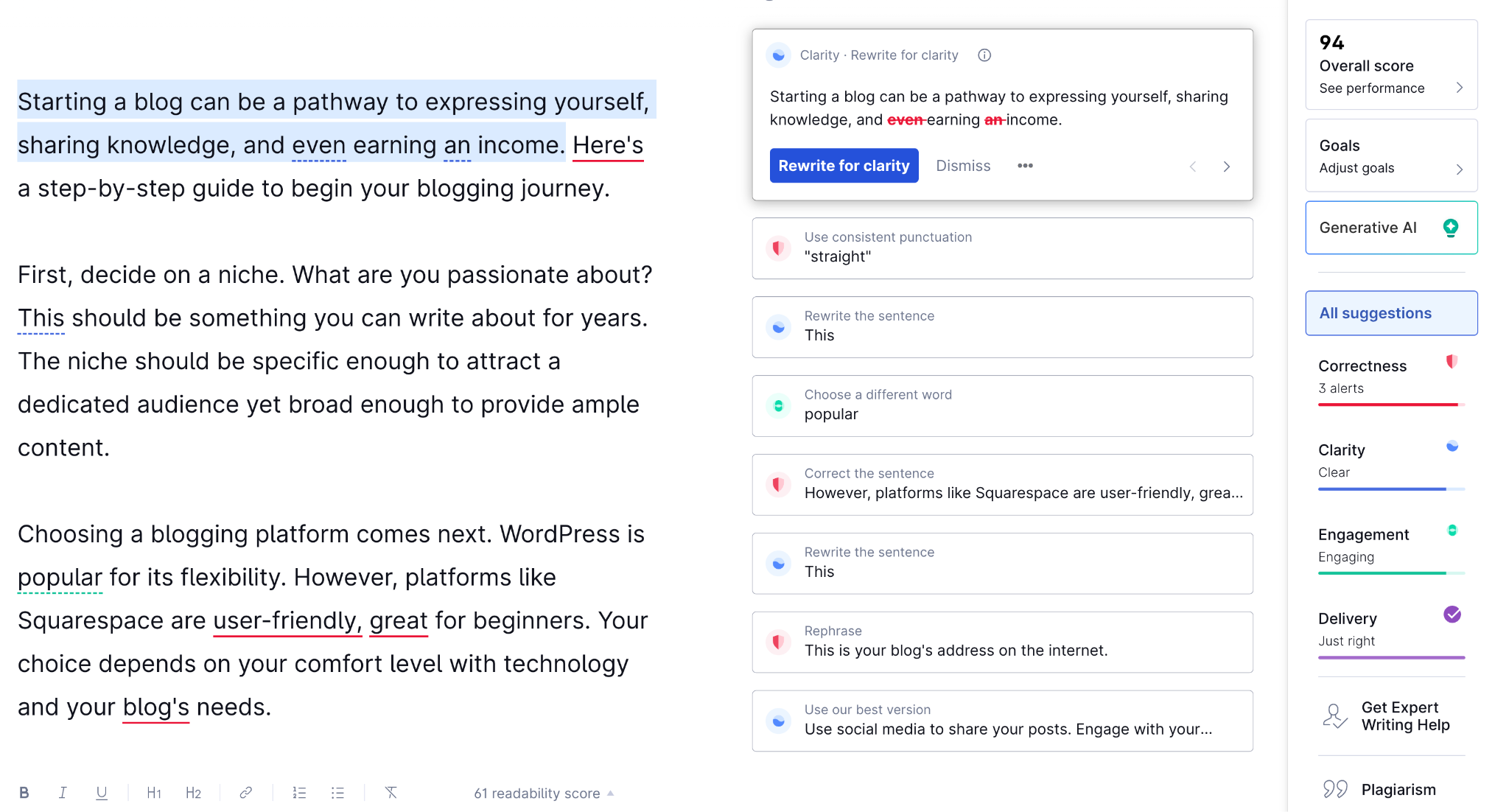
Source: https://app.grammarly.com
Using Grammarly is crucial to get error-free content. It also helps simplify any complicated terms the AI tool might have used.
This process greatly improves the overall flow of the article.
Grammarly also has a plagiarism checker. Ensuring my content is original (and not copied from other sources) is a significant factor in my content creation process.
Being Specific When Giving Prompting AI
Can you TRAIN ChatGPT? The short answer is NO.
You might hear the term “AI training” thrown around like it’s no big deal. The truth is that training an AI model is probably not something that me or you will ever do.
Training requires lots of resources and involves complex algorithms and techniques.
However, what we’re doing above is helping the AI understand what kind of output we want. We do this by providing examples of similar outputs.
The AI then recognizes the patterns and gives us results we can work with.
Since AI tools recognize patterns, being specific is critical to getting the correct output.
Humanizing AI-generated text also works this way.
If you give the AI:
- data that reflects what you’re after – helping it to model your input
- better and more specific prompts
- iterative prompts to create better output
… the results will be the most accurate and tailored to your needs.
Final Tips For Better Humanized AI Content
Here are a few final tips to consider.
Incorporating Personal Experiences
As human beings, we all have our personal experiences.
Moreover, people want to do business with those they know, like, and trust.
With the mainstream introduction of ChatGPT, everyone can generate AI content. The only difference you bring to the table is your ability to humanize the content and make it stand out.
Don’t be afraid to use personal stories, share detailed insights, or even go against the grain.
Your personal experiences will make people stop and listen.
Never Rely 100% On AI
Always check the work generated by an AI tool.
AI content can’t be published without prior checks. Even if possible, I don’t think it’s a good idea (refer to the previous point).
For starters, AI might generate false information. When you publish content online under your (brand) name, you’re responsible for it.
Moreover, here’s another point to consider. AI should be seen as an assistant.
You provide inputs, and it provides outputs. You then review these outputs and reply. It’s a dance between you and the machine.
Relying solely on an artificial intelligence model to generate your content is not a sustainable or responsible approach.
Doing this means there’s:
- no human touch to the content
- no personalization and
- no emotional connection with the audience.
Reduce Overused Phrases And Excess Formality
There are some phrases that AI loves using. This happens because of the training data that goes into training the models.
Words and phrases like:
- meticulously
- navigating
- complexities
- tailored
- ever-changing
- underpins
- towards
- realm
- ever-evolving
- meticulous
- bespoke
…stink of AI.
Imagine you’re having a conversation with a friend. Would they often use these words?
Would they say:
- ”I like my coffee meticulously crafted to perfection,” or
- “In the complexities of life, we must navigate towards our goals”?
Probably not. Not unless you’re the queen having a chat with your butler.
Use More Active Voice
Want clearer sentences that deliver your message to perfection? Go for the active voice where possible.
You can ask ChatGPT to use this voice with your prompts. If you do this, it’s a great idea to review your content and ensure you have the right output.
Whether manually or through AI:
More active voice = more engaging content.
Say Something Unique
AI can create lots of content. It can also do it fast. However, can it come up with unique ideas? Ideas that no one has ever thought of?
The answer is no.
Large language models are trained on past data. By definition, they cannot generate entirely new and unique ideas. Ideas that the world has never seen.
If you want your content to be fully humanized and unique, develop unique ideas. Present them in new stories. Use case studies that haven’t been done before. Add your personal touch and perspective.
That’s the ultimate way to humanize your content.
Lose the Fluff
Every word in your content should serve a purpose.
For example, go through these two outputs and guess which is better. Note that these outputs are straight from ChatGPT (I didn’t make any changes):
Example 1:

Example 2:
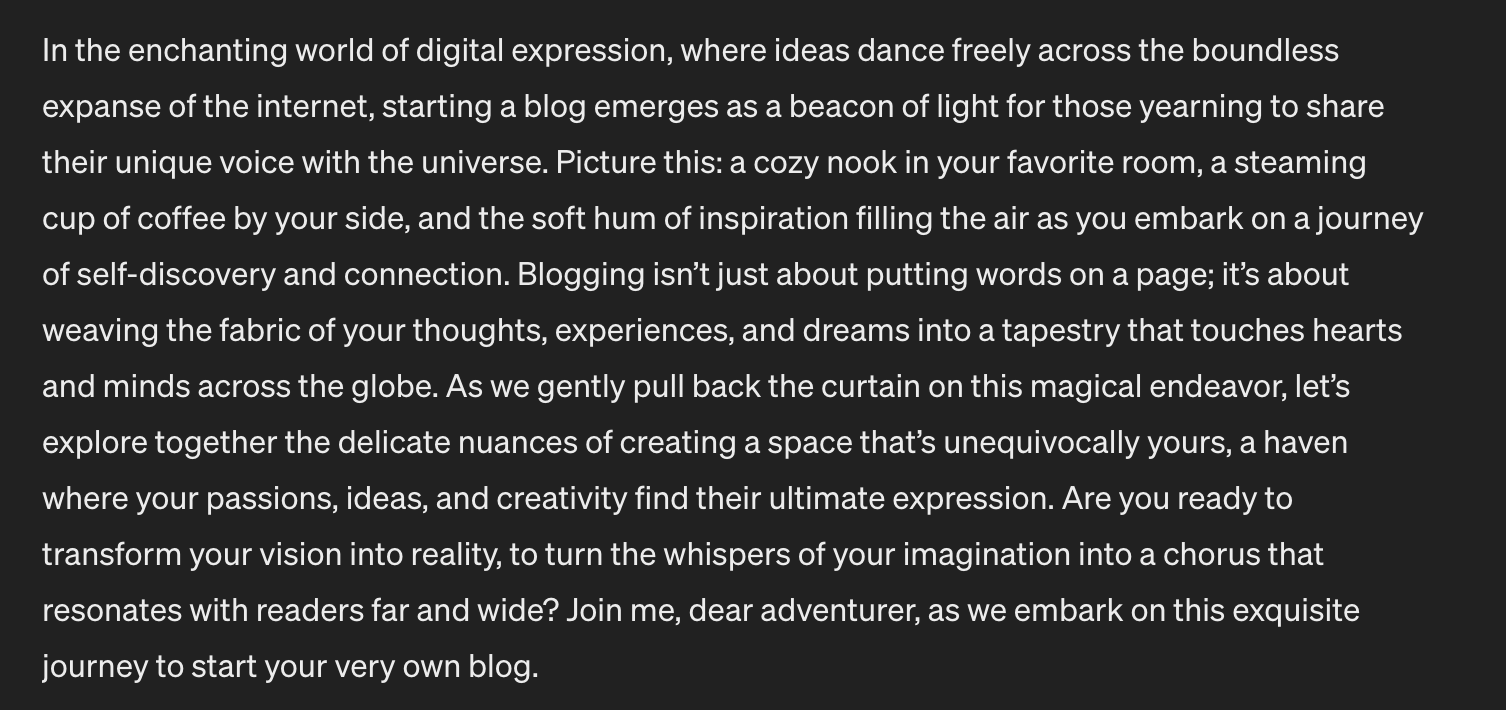
I think you would agree that example 1 is much much better.
Example 2 takes forever to get to the point. By the end of it, the reader still doesn’t know what they’ll get from reading the article.
As a result, they probably won’t (read it).
How To Humanize AI Content – FAQ
Can You Use An AI Tool To Humanize Content?
Yes, if you work with the tool to generate the right output. There’s no 100% automated solution.
At the end of the day, only a human can humanize content (duh).
I think AI will get you a reasonable length of the way there. Adding your own personal touch and perspective is what will bring the human element into your content.
Which AI Writing Tools Are Best?
It all depends on your needs. ChatGPT is a great all-rounder.
Jasper and Copy.ai have templates to help you create specific output. Check out this article on AI content tools for more information.
Why Should I Humanize AI Written Content?
People connect with stories, emotions, and personal experiences.
If you want loyal and engaged customers, you must create content that resonates with them (on a personal level). Humanizing AI-written content is how you get that.
How Does The Content Creation Process Work?
You generally start with brainstorming ideas. Here, you consider your audience as you generate ideas. These ideas should help them solve problems or hit their goals.
Then, you create the content.
Sharing your experiences, stories, and ideas (even when using AI to help) will ensure that the final output resonates with the audience.
You then polish the content (based on the output channel), and finally, publish it.
Conclusion
Want to know the best way to humanize AI content?
Share your own stories, use the right words, and ensure everything sounds natural—just like you’d say it in a conversation with a friend.
It’s not just about making our content sound human but also about connecting with our audience personally.
After all, behind every screen is a real person looking for valuable information and solutions.




